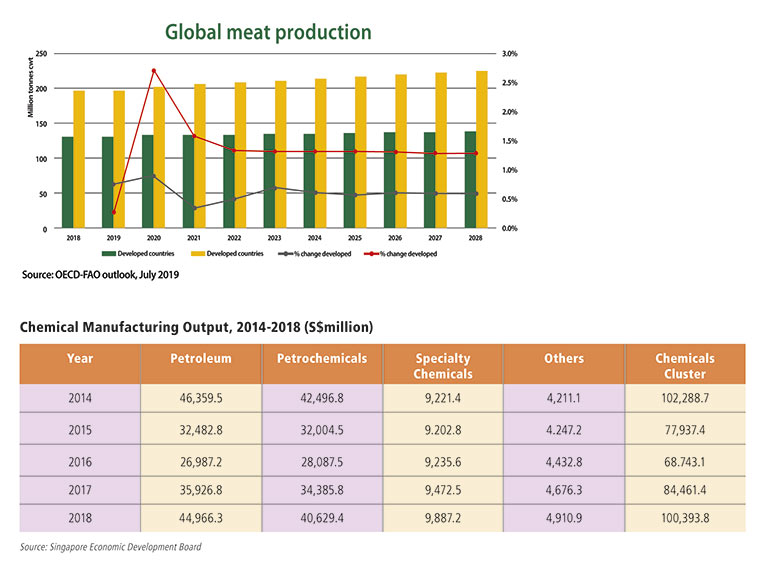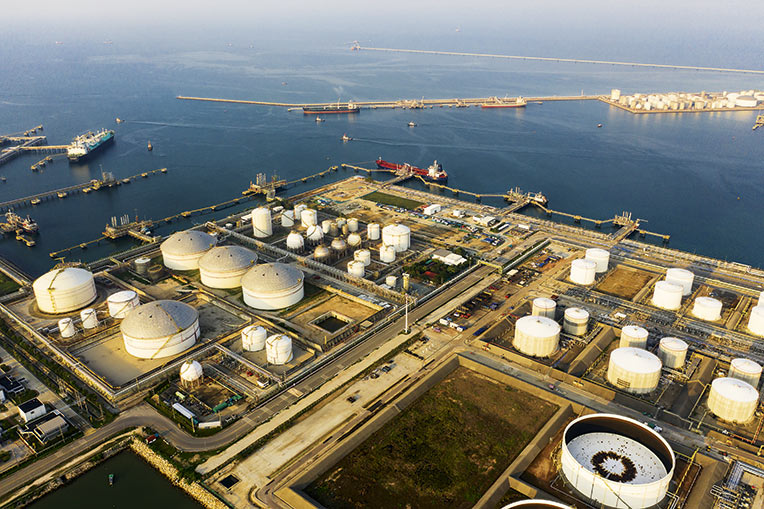 U
Used in wide ranging industries, specialty chemicals are continuing to post strong gains. Robust growth in construction activities, increasing oil exploration and production and growing requirements in major end-user sectors, including food, packaging and personal care, are buttressing demand for specialties.
Between 2019 and 2024, industry research expects demand for specialties will increase at a compound annual growth rate (CAGR) of 5.17 percent. Expansion in construction and oil exploration and production activities are key factors driving market growth during the forecast period. With its huge customer base, the Asia-Pacific will continue to dominate the market.
An integrated energy and chemicals base, Singapore is reaping the benefits of the industry’s growth in Asia. From S$6.7 billion in output in 2008, manufacturing revenue rose to S$9.8 billion in 2018, employing 9,160. While it accounted for just 9.8 percent of the chemical cluster’s total output, it contributed 25 percent to the cluster’s total value-added.
Host to some key players in the chemical industry including Basf, Bayer, Dow, DuPont, LyondellBasell Industries, Linde, Air Liquide and Toray Industries, Singapore’s focus end-markets include lubricant additives, animal health and nutrition, oilfield and water chemicals, consumer care and agricultural chemicals as well as functional chemicals such as surfactants and function polymers.
Animal health and nutrition
Spurred on by strong demand in developing countries, meat production is heading up. In a joint report, the Organisation for Economic Co-operation and Development (OECD) and the Food and Agriculture Organization (FAO) forecast that global meat production will grow by 13 percent between 2019 and 2028. With expanding population, increasing affluence and growing appetite for meat, developing countries will account for some three quarters of the growth. As the world’s most populous region, Asia will lead the way with the Philippines, Japan, Malaysia and Vietnam expected to record some of the highest levels of consumption and import growth, as demand outpaces domestic production capacity.
Demand for Asia’s animal feed as well as animal feed additives are developing in sync with the increase in meat production and consumption. The global animal feed additives market is expected to grow at a CAGR of more than 5 percent during the period 2018-2024. Reduction in the use of antibiotics, increased demand for phosphates in animal feed and growing trend of premium breeding are the key factors fuelling growth.
Amino acids - key nutrients in animal growth, production and reproduction – will outstrip the average. Asia Pacific, the largest animal feed additives market globally, is expected to register 34 percent growth in amino acids because of the need to improve livestock quality.
Singapore is host to Evonik, a leading manufacturer of methionine, an essential amino acid required for balanced animal nutrition. Its two methionine plants on Jurong Island are the largest within Evonik. Completed in 2014 and 2019 at the total cost of about 1 billion euros, they have a combined production capacity of 300,000 tonnes per annum, accounting for over 40 percent of Evonik’s global production.
Speaking at the opening at the second plant in June 2019, Mr Christian Kullmann, chairman of the Executive Board of Evonik, said, “Our methionine complex on Jurong Island, which we commissioned in late 2014 has been a real success story. Now, we want to continue the success story with this second plant.”
Singapore also serves as group’s headquarters for the Asia-Pacific South - a region stretching from Pakistan to New Zealand – as well as a centre for innovation. Located in Biopolis, the Evonik Asia Research Centre undertakes research in functional surfaces and additive manufacturing for the specialty chemicals giant, which also makes materials and additives for automotive, coatings, construction, rubber, plastics and other industries.
Lubricant additives and lubricants
Demand for global lubricant oil additives, chemical compounds used to enhance the performance of lubricant formulations, is also heading higher on global vehicle fleet expansion and increasing concern over the environment. As lubricant additives can improve fuel economy and flow efficiency of passenger and commercial vehicles, as well as industrial equipment, they are vital ingredients in modern lubricants.
In its new report, Reports and Data expects the global lubricant oil additives market to expand at a CAGR of 2.5 percent from US$15 billion in 2018 to reach US$18.4 billion by 2026. Increased demand for global lubricating oil additives, especially in the automotive sector and the need to increase machine efficiency in the expanding industrial sector are propelling market growth.
As much of the demand growth is in the Asia Pacific, manufacturers are ramping up their presence in Singapore, a key manufacturing hub for lubricant additives in Asia. With Singapore’s robust intellectual protection (IP) regime, one of the strongest in the world, companies can manufacture here knowing that their IP will be well protected. Singapore also has a well-established base of finished lubricant producers, which are key customers of lubricant additive companies.
Afton has a chemical additive manufacturing facility on Jurong Island which produces core engine oil additives for the Asia Pacific. Following the completion of its S$222-million expansion in September 2018, the Singapore plant can produce advanced ashless dispersants and anti-wear components, which are critical in several of the company’s products. It can also help passenger vehicles and commercial vehicles meet performance standards of the future.
Chevron Oronite’s lubricant additives manufacturing facility in Singapore is its largest in Asia. At its 23-hectare site on Jurong Island, Chevron Oronite has added a carboxylate production unit to manufacture sulphur-free detergents, used to produce environmentally friendly fuels and lubricants.
Infineum’s plant in Singapore - its first in the Asia-Pacific region – produces calcium salicylate, a critical detergent component of the company’s passenger car, heavy-duty and marine lubricant formulations.
As for Evonik, its oil additives plant on Jurong Island is the largest facility within the group following an expansion in 2015. The enlarged plant also features improved automation to reduce energy consumption and waste, reflecting Evonik’s strong focus on resource efficiency.
Encouraged by Asia’s growth, lubricant producers are also expanding their capacity and improving their capability. In April 2019 ExxonMobil unveiled a multi-billion-dollar programme to expand its manufacturing complex in Singapore, its largest integrated refining and petrochemical complex in the world, to convert fuel oil and other crude products into higher value lube base stocks and distillates.
The investment, the latest and most significant refinery investment in base stock production in Singapore, will boost the plant’s capacity by an extra 20,000 barrels a day of its Group II base stock oil and 48,000 barrels a day of cleaner fuels with lower sulphur content, including the high-quality marine fuels required by the International Maritime Organization.
Bryan Milton, president of ExxonMobil Fuels & Lubricants Company, said, “By using a combination of proprietary catalyst and process technologies, we will increase the site’s competitiveness and help meet growing demand for high-performance lubricants and cleaner fuels.”
Engineering, procurement and construction activities for the expansion have started and operations are expected to begin in 2023.
In the same month, the group’s chemical arm, ExxonMobil Chemical, officially opened two new plants on Jurong Island. The halobutyl rubber plant, which began commercial production in the second half of 2019, produces up to 140,000 tonnes a year. By using halobutyl rubber to keep tyres properly inflated, vehicle owners can lower fuel consumption, and hence reduce vehicle carbon emissions.
Its second new plant is equipped to produce up of 90,000 tonnes annually of its proprietary product, Escorez hydrogenated hydrocarbon resins. Operational since December 2017, it is the world’s largest of its kind. Hydrogenated hydrocarbon resins are used in hot-melt adhesives, typically used in packing or baby diapers.
“Expansion projects like this enable us to better serve the Asia Pacific region, the key growth market globally for these specialty chemicals. These two new specialty chemical plants will strengthen ExxonMobil’s competitive manufacturing base to help meet market demand for these high-performance products,” said Karen McKee, president of ExxonMobil Chemical Company.
Fast facts about Singapore chemicals
- Singapore was ranked the 7th largest exporter of chemicals in 2018 by the World Trade Statistical Review
- With revenues of S$100.4 billion in 2018, the chemical industry came second only to electronics in Singapore’s manufacturing sector
- Specialty chemicals is the smallest sector in the chemical cluster generating revenues of S$9.8 billion in 2018, 9.8 percent of the total, but accounted for 25 percent of its value added

